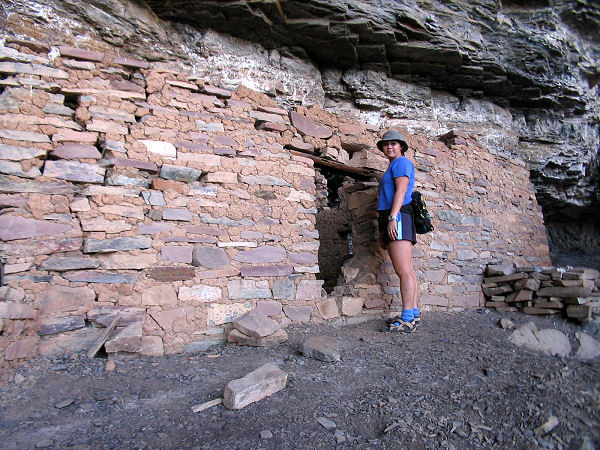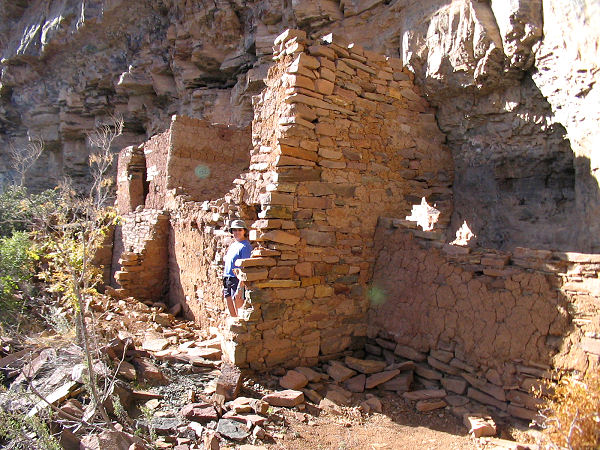| |
Pueblo Canyon - Sierra Ancha Wilderness, Tonto National Forest
| Summary: |
Pueblo Canyon is located in
the Cherry Creek area of the Sierra Ancha
Wilderness. The hike involves a steep climb up a
remote canyon to well preserved Salado Indian ruins.
Remember, ruins are
fragile and irreplaceable, please leave the area
as you found it. |
|
| Directions: |
From Phoenix
drive east on Highway 60 almost to Globe. Turn
left (north) on Highway 188 (also listed as 88
on maps) and drive 14.4 miles to Highway 288.
Turn right on 288 which soon crosses the Salt
River on a single lane bridge. After 6.7 miles,
turn right onto the well graded, dirt Cherry
Creek Road (which is also Forest Road 203).
After 8.8 miles at the sign for Coon Creek FR
#203 bends right and crosses the creek (straight
will take you onto private ranch property). At
the 13.3 mile point you reach a sign for the
left branching Bull Canyon Road (FR #203A), stay
straight on FR #203. After passing the Ellison
Ranch, the road becomes considerably rougher and
rockier and soon you'll reach a Forest Service
sign which reads:
| "Sierra Ancha Cliff Dwellings:
Prehistoric cliff dwellings are located in
several of the rugged canyons within and near
the Sierra Ancha Wilderness. They were built
between 1280 and 1350 AD by indians known
presently as the 'Salado'. Why they chose to
utilize this challenging environmental
zone is not yet fully understood. Cliff
dwellings are fragile and irreplaceable.
Please do not climb on the walls, or roofs
or cause any other form of injury or
disturbance. Violators are subject to
arrest, fines and or imprisonment."
|
| At the 22
mile point on the Cherry Creek Road you'll drive
down a steep embankment and cross Devils
Chasm Creek. Drive another 1.5 miles to a
point where the road makes a sharp left
turn, park at the small pull off with fire
ring on the right (the gps coordinates are UTM
0512429mE, 3744368mN). |
|
|
| Road Conditions: |
High
Clearance Vehicle. |
|
| Navigation: |
Moderate |
|
| Length: |
~5-6 hours |
|
| Date Hiked: |
November
2003 |
|
| Weather Conditions: |
Cool and
sunny |
|
|
Required Skills: |

 |
| Hike Description: |
From the pull off, walk
across the road and you'll see a new metal
interpretive sign which describes the ruins in
the area. Follow the somewhat faint path up the
hill through the junipers and shortly you will
reach an old, rocky ranch road. Turn right on
this road and continue up the moderately steep
hillside. A bit of climbing will bring you to a
point where the road splits
(UTM 511609mE, 3744402mN), left heads towards
Cold Spring Canyon, straight takes us to Pueblo.
Stay straight at the fork. The path becomes more
trail-like as it climbs beside an unnamed side
drainage before bending right to climb above a
prominent cliff band. Above the cliff band, the
trail winds its way north, at first through
manzanita, then, as you gain altitude, through
scrub oak. There are a few false paths in the
area, but all the wrong ones fade within 20 feet
or so. If you find that the path you are
following seems to disappear, just backtrack a
short distance and try again. Eventually the
trail tops out at a tall cliff band with views
across the canyon of the ruins. Continue along
the base of the cliff band into Pueblo Canyon.
Soon you will reach a high alcove with an old
mine tunnel (which only goes back into the
mountain about 100ft) and a ruin. Continue into
the canyon to the headwall which features a
sprinkling waterfall (at least during the wetter
parts of the year) and around the other side to
the south facing cliff face. Along this wall
you'll find a series of well preserved ruins and
walls. When ready, return the way you came. |
|
| Rating (1-5 stars): |
   
The author and several friends completed
this hike in 5.5 hours with about an hour spent
photographing the ruins. |
|
| Books: |
None |
|
| Maps: |
Tonto
National Forest, USFS (not a very good map) |
| Photos: |
Click picture for larger view, click your browser's 'Back' button to return to this page. |
|
 |
 |
Climbing up to
Pueblo Canyon. |
The ruin
near the old mine. |
 |
 |
|
Wall and doorway. |
More Salado ruins. |
|
|

